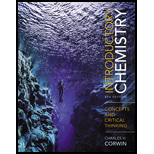
(a)
Interpretation:
The formula for chromium(III) chlorate is to be stated.
Concept introduction:
The chemical formula is used to represent a compound. It tells about the proportion of the elements present in the compound. The elements in the chemical formula are represented by the chemical symbols.
(b)
Interpretation:
The formula for lead(II) sulfite is to be stated.
Concept introduction:
The chemical formula is used to represent a compound. It tells about the proportion of the elements present in the compound. The elements in the chemical formula are represented by the chemical symbols.
(c)
Interpretation:
The formula for tin(IV) carbonate is to be stated.
Concept introduction:
The chemical formula is used to represent a compound. It tells about the proportion of the elements present in the compound. The elements in the chemical formula are represented by the chemical symbols.
(d)
Interpretation:
The formula for iron(II) chromate is to be stated.
Concept introduction:
The chemical formula is used to represent a compound. It tells about the proportion of the elements present in the compound. The elements in the chemical formula are represented by the chemical symbols.
Want to see the full answer?
Check out a sample textbook solution
Chapter 6 Solutions
Introductory Chemistry: Concepts and Critical Thinking Plus MasteringChemistry with eText -- Access Card Package
- How should the formula of iron(III) nitrate nonahydrate be written?arrow_forwardQuestion Which of the following is the chemical formula of antimony (V) sulfide?arrow_forwardWhich of the following is not a ternary ionic compound: potassium nitride, potassium nitrate, or potassium nitrite?arrow_forward
 World of Chemistry, 3rd editionChemistryISBN:9781133109655Author:Steven S. Zumdahl, Susan L. Zumdahl, Donald J. DeCostePublisher:Brooks / Cole / Cengage Learning
World of Chemistry, 3rd editionChemistryISBN:9781133109655Author:Steven S. Zumdahl, Susan L. Zumdahl, Donald J. DeCostePublisher:Brooks / Cole / Cengage Learning
